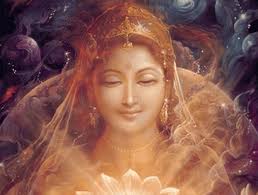
By Steve Beckow, May 9, 2021
(Golden Age of Gaia)
Happy Mother’s Day to all mothers!
On Mother’s Day, perhaps I can contribute by looking at the Mother’s discussion of what differentiates her from the Father.
In late 2012, the Divine Mother, speaking through Linda Dillon, joined us on An Hour with an Angel and responded to our request to discuss this subject, if that was possible. We repost her answer here.
But before turning to that, perhaps I can give a little background to it.
The Divine Mother is the transcendental One (which “She” designates as “He”) entering into the created world. He is still and she is movement. (1) Inside the world of form, she operates as its creator, preserver, and transformer for the purpose of realizing and fulfilling the Divine Plan.
The Divine Plan is that each of us should realize itself, through a process of gradual spiritual evolution and sudden enlightenment. When we do, God meets God, for which meeting all of life was created. Hindus call this a leela or divine play.
The Divine Mother is here discussing the highest levels of Reality.
The three actors or levels of reality are the Father, Mother, and Child (the latter better known as the Self, Christ, soul). This Trinity in Hinduism is known as Brahman, Shakti, and Atman.
The Mother uses the family as an understandable metaphor for the Transcendental, the Phenomenal, and the Transcendental in the Phenomenal.
Steve Beckow: Mother, you say you are movement, and that implies that the Father is stillness. But you are the Father as well as the Mother. Can you, if at all possible, explain to our listeners what the difference is between your aspect as the Mother and your aspect as the Father?
Divine Mother: Yes, because, as I have said, I am All, I am One. And, if you will, as you will be speaking with the Father, (2) of course there will be more information. But also know, I am All. So, I give you human ways, not by way of speaking down — quite the contrary — but in ways that you may understand. When I am Father, there is a stillness, complete.
This is something that the human race is simply learning now. It is the union and conjoining of stillness with movement, and how that is the balance of everything. When I am in the Father, I do not require that movement, for that is not the way that I have created the Father. (3) So, they are the two halves of the whole. Many who listen to this will be a little confused, and yet, my children, there is no need for confusion.
Let me explain further. In many traditions, I am considered the Mother of All; in some traditions, the Mother of God, Source, One. Now, what does this mean? It means exactly what it says: I am the beginning and I am the completion, the end. Each of you — and I have strongly encouraged you not only to discover but to find the masculine aspect of yourself, and the feminine, the stillness and the movement — you cannot have creation of any kind without both.
Creation comes from movement, and it is movement into form, into energy, into substance, into essence — however you conceive of that. But do not negate the role of the Father, of the masculine, because in that is the stillness of what you think of as the moment of creation. So it is the combination.
You say, “Mother, how can you do both?” It is who I am. And you, each one of you, are embedded with these qualities directly from my being, from my heart. I give you human ways rather than just sheer energy, which I also transmit to you now, but not only to embrace me, but to understand, because you are in your process also of fulfillment. It is part of your progression. It is already created.
I invite you to stay in the Now but also suggest to you and tell you, it is already done.
Footnotes
(1) “When I think of the Supreme Being as inactive — neither creating nor preserving nor destroying — I call Him Brahman [God] or Purusha [the Divine Person], the Impersonal God. When I think of Him as active — creating, preserving, and destroying — I call him Sakti or Maya or Prakriti [Procreatrix], the Personal God.
“But the distinction between them does not mean a difference. The Personal and the Impersonal are the same thing, like milk and its whiteness, the diamond and its lustre, the snake and its wriggling motion. It is impossible to conceive of the one without the other. The Divine Mother and Brahman are one.” (Paramahansa Ramakrishna in GSR, 32.)
(2) The planned interview never happened, probably because I was still reactivated about the father side of things and allowed it to fall off the table.
(3) Sometimes the Mother is speaking of what Hindus call the unconditioned Brahman and sometimes the conditioned Brahman.
The unconditioned Brahman is God outside the domain of form, of matter, mater, Mother, the Transcendental, still and silent God.
The conditioned Brahman, which the Mother has created, is the Transcendental imported into the domain of matter and clothed in form. Before we say we have difficulty imagining that, keep in mind that each one of us is the Transcendental (the soul) clothed in form (the bodies). We are walking, breathing miniatures of Mother/Father God.
Mother God, Father God: Which is Which? | Steve Beckow
![Mother God, Father God: Which is Which? | Steve Beckow]() Reviewed by TerraZetzz
on
5/09/2021 11:16:00 PM
Rating:
Reviewed by TerraZetzz
on
5/09/2021 11:16:00 PM
Rating:



